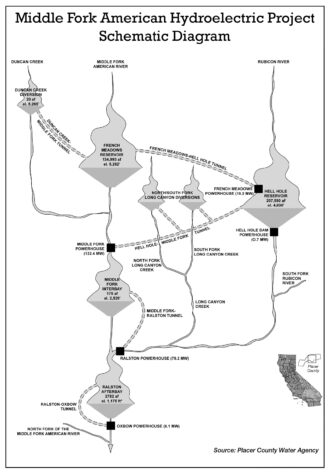Restore the Delta is a tiny organization with a big mission — keeping the Sacramento–San Joaquin Delta “fishable, swimmable, drinkable, and farmable.” That’s also the slogan of this feisty, four-year-old conservation group. “Our message is that the Delta is a place worth preserving,” said Barbara Barrigan-Parrilla, campaign director of the group, which advocates for a wide range of fish species in the Delta, rather than just the threatened and endangered species. The Stockton Record newspaper called the group a “formidable watchdog” over the complex issues involving the Delta.
Being called “formidable” is quite a compliment, because the group’s foes in the rancorous Delta debate are such powerhouses as the Metropolitan Water District of Los Angeles, the Westlands Water District, the Kern County Water Agency, and the State of California. All have highly paid lobbyists, attorneys, staff scientists, and water experts in offices scattered across California. The Stockton-based Restore the Delta, conversely, has just three staff members, two of whom work parttime, and a student intern. But the group makes up for its size with highly motivated volunteers who are working to reverse the declining fishery and preserve the rural way of life in the Delta, a 492,000-acre estuary south of Sacramento that is home to 54 species of fish and through which drinking water flows for 25 million Californians.
The group bills itself as a “coalition of Delta residents, community groups, farmers, business leaders, fishermen, faith-based communities, unions, and environmentalists.” Restore the Delta’s supporters are motivated because many live, work, fish, or recreate in the Delta, which has just over half a million residents, four cities, and 14 small towns and villages. Some 12 million people use the Delta for recreation each year, many fishing from boats out of its 300 marinas, according to the Delta Protection Commission.
The group’s 12-member board of directors reflects the Delta orientation and includes South Delta business owners Mike Robinson, president of Robinson Farms Feed Company, and Robert Ferguson, who owns Ferguson Farms, as well as and Rogene Reynolds, a student and lifelong resident of Roberts Island. The group’s member organizations include the California Delta Chamber of Commerce, the Sportsmen Yacht Club, the Central Delta Water Agency, Stockton’s Delta Fly Fishers, and Water 4 Fish. In addition to the down-home board members, the group is also supported by longtime Delta conservation players. For example, serving on the board is Steve Evans, conservation director of Friends of the River, and Bill Jennings, executive director of the California Sportfishing Protection Alliance (CSPA). And member groups also include the national conservation organizations Earthjustice and the Natural Resources Defense Council, as well as the CSPA.
The work of Restore the Delta involves letting people know the Delta is a special place and highlighting positive solutions to its problems, such as pushing for increased water conservation to preserve the area. “We want people to know it’s not all gloom and doom in the Delta,” Barrigan-Parrilla told the audience at a recent educational presentation in Stockton.
That may be an uphill battle, because there continues to be lots of gloomy Delta fishery news, particularly regarding the declining populations of striped bass, salmon, steelhead trout, longfin smelt, and Delta smelt, a species of minnow that is teetering on the brink of extinction. The California Department of Fish and Game’s annual seine sample in 2010 produced a population index for Delta striped bass of 1.5, compared with a high of 117.2 in 1965. The index is a relative number that reflects the population of fish in the Delta at a given time. The fish that best indicates the environmental health of the area is the Delta smelt, which has been listed as endangered since 2008. In 2010, the DFG’s index for the Delta smelt was 0.8, com-pared with a high of 62.5 in 1968. Simi-larly, salmon and steelhead runs have declined over the years, although some recent improvement has been evident. The plummeting fisheries prompted American Rivers, a national conservation group, to list the Delta in 2009 as one of the most endangered waterways in our country.
A project that could lead to further decline in the Delta’s fish populations is the Peripheral Canal, which Restore the Delta opposes. “Peripheral Canal” is the name given to a proposed structure that would have routed water around the Delta, but that statewide voters rejected in 1982. Northern California voters opposed the project because they suspected the canal would shunt water to fast-growing areas in Southern California and cause too many environmental impacts.
State planners are now considering another version of the Peripheral Canal — this one is known as the “Dual Conveyance” — which could result in construction of two 35-mile-long, 33-foot-diameter underground pipes or an open, cement-lined canal, either of which would divert part of the Sacramento
River’s flow just south of Sacramento and transport it to Tracy, where existing pumps would send the water to Southern California. The pipes would have the capacity to divert water at a rate of 15,000 cubic feet per second. The average flow of the Sacramento River is 30,000 cfs. A decision on this $20 billion project is expected later this year. (It’s called the “Dual Conveyance” because the pipes would be used in conjunction with water flowing to the Tracy pumps through the eastern Delta using existing rivers, which would be shored up with earthquake-proof levees.)
This approach to controlling and keeping water flowing south in the event of a devastating earthquake has been recommended in the recently released Bay Delta Conservation Plan (BDCP), which is being supported by U.S. Senator Dianne Feinstein and Governor Jerry Brown, who has rehired a well-known environmentalist, Jerry Meral, to lead the effort to gain approval and find funding for the Dual Conveyance project. During the first Brown administration, Meral worked as an advocate for the Peripheral Canal under the condition that Delta residents and environmentalists, rather than utilities and water users, manage its operation.
“Political resistance to building the circum-Delta facility has traditionally come from Northern California, which claimed that no matter what constitutional protections were in place, the facility operators could not be trusted to operate it in a way that would not damage the Bay Delta environment,” Meral wrote in a 2005 position paper. “One way to respond to this concern is to build the pipeline with (the State of California’s) general funds and then turn it over to a new Northern California based operating agency.” Possible members of the agency, Meral suggests, could be representatives of the “Delta counties, commercial and sportfishing interests and environmentalists.” Water contractors would not have positions that vegetation and trees be removed from levees, because their roots weaken them.
Pyke also suggests that the Delta needs a well thought out plan for maintaining levees that includes a secure source of funds, but funding his or any other Delta improvements could be challenging during a sour economic climate, particularly when there is no agreement on a bond to pay for the work. State agency leaders have proposed asking for voter approval of an $11.14 billion bond, but the measure has been put on hold, partially because it contained some money for the Peripheral Canal, which is opposed by most of the state’s conservation groups, including Restore the Delta and the CSPA.
Restore the Delta’s other projects include improving water quality and quantity to meet federal Clean Water Act standards, reducing water exports to levels that will restore and sustain the Delta, supporting levee repairs to protect urban areas and farmlands while advocating for comprehensive flood-management planning, protecting the economic interests of the Delta, including fishing, farming, marinas, recreation, and tourism, and promoting the Delta Conservancy organization, which will act as a funding vehicle for state and federal restoration efforts while enhancing Delta agricultural activity.
The Delta Conservancy was created last February as a new state agency charged with restoring the Delta. Policy for the fledging agency is set by an 11-member Delta Conservation Board, which includes Chuck Bonham, Trout Unlimited’s California director. The Delta Conservancy is writing a long-range strategic plan to guide its work, focusing on on-the-ground restoration projects to improve fish populations, wildlife, and ecosystems in the Delta. Limited funding has slowed the Delta Conservancy’s progress, which may be accelerated with the hiring of an executive director, Campbell Ingram, a former staff member of The Nature Conservancy. The Delta Conservancy’s charge when created by the state legislature is much like that of Restore the Delta’s — to restore the estuary while improving the local economy.
In the future, Restore the Delta and the Delta Conservancy will have to wrestle with how much emphasis to place on restoring habitat for striped bass, a popular game fish, but one that other agencies say has an appetite for minnows, including the Delta smelt. The National Marine Fisheries Service has asked the California Fish and Game Commission to remove the bag limit on stripers in the Delta as a way to improve the size and health of other game and nongame fish populations.
The stripers-versus-smelt flap has resulted in renowned University of California–Davis fishery biologist Dr. Peter Moyle arguing in a recent academic article that removing the striped bass could upset the delicate balance of fish populations in the Delta and possibly do more harm than good for that estuary’s threatened and endangered species. “Seven species of fish in the Delta are listed as threatened or endangered, including Delta smelt, salmon, and steelhead,” said Moyle in the piece, which reviewed proposals to protect and restore these species. “One proposal is to kill as many striped bass as possible. Striped bass are an abundant non-native predator, so it is presumed that reducing [their] numbers will increase populations of threatened fishes.”
That presumption could be true, Moyle argues, but only if other fish-species populations didn’t change after the stripers were gone — something that rarely happens in complex aquatic ecosystems such as the Delta. “For example, Mississippi silversides are important in the diets of one to three year old striped bass, so bass predation may be regulating the silverside population,” argues Moyle. “Fewer striped bass could result in greater silverside numbers, which may have negative effects on Delta smelt through predation on eggs and larvae.”
Striped bass are not too fond of eating Delta smelt, according to Moyle, who adds that surveys show they prefer steelhead and hatchery-raised salmon, which are poorly adapted to the wild. “The most abundant fish predator in the Delta today is probably largemouth bass,” said Moyle. “If a control program for striped bass can be justified, then presumably one should be instituted for other predators as well.”That could make a lively debate if the Fish and Game Commission considers the striper and Delta predator issue in 2012, when it is scheduled to review changes in state angling regulations.
“Fewer striped bass could result in greater silverside numbers, which may have negative effects on Delta smelt through predation on eggs and larvae.”
Dr. Peter Moyle
Also in the future, Restore the Delta and the Delta Conservancy will be wrestling with the issue of whether to allow new or modified dams on rivers to create water storage that would benefit the Delta. Currently, state water planners are considering raising Shasta Dam by 18.5 feet, which would cost $1 billion and inundate parts of the upper Sacramento and McCloud Rivers. Also being considered are new dams: a $3.6 billion Sites Reservoir in Colusa County and Temperance Flat, a new reservoir on the San Joaquin River, which does not yet have a firm cost. For more information, contact Restore the Delta, 10100 Trinity Parkway, Suite 120, Stockton, CA 95219; phone (209) 479-2053; on the Web at storethe-delta.org.
Conservation News: Stan Griffin Passes Away
Trout Unlimited volunteer Stan Griffin died peacefully in March at the age of 91. Known as an inspirational and tireless leader, Stan served more than thirty years as a fisheries advocate in the San Francisco Bay Area, spearheading projects to improve fish passage on rivers and streams in Marin and Sonoma Counties, and fighting to limit in-stream mining and fish-threatening water diversions in the North Bay region. His work led directly to legislation that improved flows for salmon and steelhead in the Russian River and in coastal streams from San Francisco to the Mattole River. Over the years, Stan received many awards, including the Mortensen Award, Trout Unlimited’s highest honor, and TU recognized him as one of the ten individuals who have had the greatest impact on the nation’s salmonid fisheries during the organization’s 50-year history.
Trout Unlimited Press Release
The Delta Fly Fishing Challenge
The Stockton-bassed Delta Fly Fishers has initiated “The Delta Fly Fishing Challenge,” through which anglers receive a certificate if they catch six of 15 species of sport fish that inhabit or pass through the Sacramento–San Joaquin Delta. “We hope by providing an incentive we can showcase the variety of fish and reasons for protecting our resources,” said Bob Fujimura, a director of the club, in a news report published in the Stockton Record. Anglers interested in participating in the challenge, which has no time limit, can find more information at www.deltaflyfishers.com.
Richard Anderson














